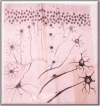History of Neuroscience I. Pío del Río-Hortega (1882-1945): The Discoverer of Microglia and Oligodendroglia
- PMID: 33070631
- PMCID: PMC7580141
- DOI: 10.1177/1759091420953259
History of Neuroscience I. Pío del Río-Hortega (1882-1945): The Discoverer of Microglia and Oligodendroglia
Figures



References
-
- Cajal S. R. (1913. a). Un nuevo proceder para la impregnación de la neuroglia [A new procedure for the impregnation of neuroglia]. Boletín de la Sociedad Española de Biologia, 2, 104–108. Cajal succeeded in being the first to stain both fibrous and protoplasmic astrocytes with unequaled selectivity while neurons remained pale, using a gold and mercury chloride-sublimate technique.
-
- Cajal S. R. (1913. b). Contribución al conocimiento de la neuroglia del cerebro humano [Contribution to the knowledge of the neuroglia of the human brain]. Trabajos del Laboratorio de Investigaciones Biológicas de la Universidad de Madrid, 11, 255–315. Cajal famously designated neuroglia cells he could barely visualize, despite his staining artistry and genius, as the “third element.”
-
- Río-Hortega P. D. (1919). El “tercer elemento” de los centros nerviosos [The “third element” of the nerve centers]. Boletín de la Sociedad Española de Biología, 9, 68–166. I. La microglía en estado normal (pp. 68–82) II. Intervención de la microglía en los procesos patológicos (pp. 91–103) III. Naturaleza probable de la microglía (pp. 108–120) IV. Poder fagocitario y movilidad de la microglía (pp. 154–166) These four installments (I to IV) published back to back in the same journal issue formally introduced microglia to the world. Microglial cells had been formerly described i.e. by Alzheimer in the late 19th century, but until the 1919 Río-Hortega series, microglia were just strange amoeboid cells. Río-Hortega devised a staining which showed microglia in all their activation states from resting ramified to phagocytosing amoeboid, thereby establishing a new cell type and showing its versatility.
-
- Río-Hortega P. D. (1921). Estudios sobre la neurologia. La glía de escasas radiaciones (oligodendroglía) [Studies on neurology. Low-radiation glia (oligodendroglia)]. Boletín de la Real Sociedad Española de Historia Natural, 21, 63–92. This article introduced the oligodendrocyte as a new cell type. This report antagonized Cajal more than the newly described microglial cell, because Cajal was now famous world-wide and had already received the Nobel Prize. Despite his staining genius, Cajal failed in visualizing oligodendrocytes which he dubbed the” third element” or “apolar elements” since he could never see their processes. Cajal finally acknowledged the existence of oligodendrocytes a mere 5 years before his death in a personal letter to Pío, but never in a scientific publication.
-
- Río-Hortega P. D. (1928). Tercera aportación al conocimiento morfológico e interpretación funcional de la oligodendroglia [Third contribution to the morphological knowledge and functional interpretation of oligodendroglia]. Memorias de la Real Sociedad Española de Historia Natural, 14, 5–122. The sum of a monumental amount of work on oligodendrocytes of which we are still rediscovering. Essentially everything Pío discovered about oligodendrocytes is contained in this book of 120 pages. The classification into four cardinal types depending upon the orientation and size of myelinated axons is still used to this day.
Publication types
MeSH terms
Personal name as subject
- Actions
LinkOut - more resources
Full Text Sources

